After investigating the high-standing bedrock at the Bunsen Peak workspace deep within the Margin Unit, the unique nature and composition of this rock was deemed worthy for collection of Perseverance’s 24th rock core sample, Comet Geyser!
23.01.2024
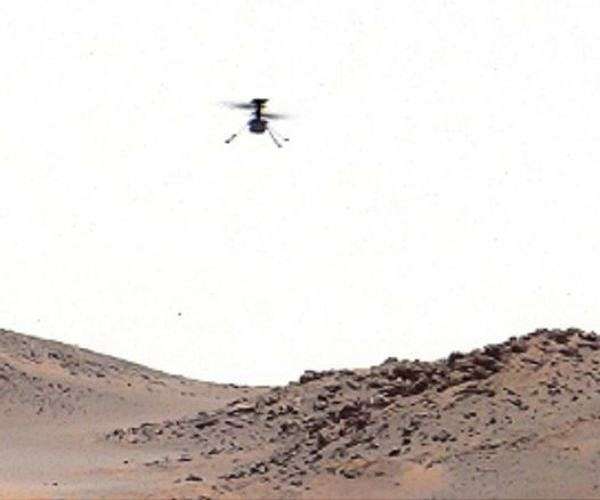
NASA has re-established contact with its tiny helicopter on Mars, the US space agency said Saturday, after an unexpected outage prompted fears that the hard-working craft had finally met its end.
Ingenuity, a drone about 1.6 feet (0.5 meters) tall, arrived on Mars in 2021 aboard the rover Perseverance and became the first motorized craft to fly autonomously on another planet.
Data from the helicopter are transmitted via Perseverance back to Earth, but communications were suddenly lost during a test flight on Thursday, Ingenuity's 72nd lift-off on Mars.
"Good news today," NASA's Jet Propulsion Laboratory (JPL) wrote on X, formerly Twitter, late Saturday.
The agency said that contact had finally been made with the helicopter by commanding Perseverance to "perform long-duration listening sessions for Ingenuity's signal."
"The team is reviewing the new data to better understand the unexpected comms dropout during Flight 72," it added.
NASA previously said that Ingenuity had attained an altitude of 40 feet (12 meters) on Flight 72, which was a "quick pop-up vertical flight to check out the helicopter's systems, following an unplanned early landing during its previous flight."
But during its descent, "communications between the helicopter and rover terminated early, prior to touchdown," the agency said.
JPL had noted on Friday that Perseverance was temporarily "out of line-of-sight with Ingenuity, but the team could consider driving closer for a visual inspection."
In a response to a post on X asking if Ingenuity would be able to fly again, JPL said Saturday that "the team needs to assess the new data before that can be determined."
NASA has lost contact with the helicopter before, including for an agonizing two months last year.
The mini rotorcraft, which weighs just four pounds (1.8 kilograms), has far exceeded its original goal of undertaking five flights over 30 days on the red planet.
In all, it has covered just over 10 miles (17 kilometers) and reached altitudes of up to 79 feet (24 meters).
Its longevity has proved remarkable, particularly considering that it must survive glacially cold Martian nights, kept warm by the solar panels that recharge its batteries during daylight hours.
Working with Perseverance, it has acted as an aerial scout to assist its wheeled companion in searching for possible signs of ancient microbial life.
Quelle: SD
----
Update: 14.02.2024
.
Solar eclipse on Mars! Perseverance rover sees Martian moon Phobos cross the sun in epic video
"Fear" briefly darkened the sun.

The moon Phobos passes in front of the sun in an image taken by the NASA Perseverance rover on Feb. 8, 2024. (Image credit: NASA/JPL-Caltech/ASU)
Fear passed in front of the sun last week, and a NASA rover saw it fly.
The Mars moon Phobos, whose name means "Fear" in ancient Greek, was caught on camera by the NASA Perseverance rover on Feb. 8. The potato-shaped moon was visible in front of the sun from Percy's current perch in Jezero Crater.
Engineers from NASA's Jet Propulsion Laboratory (JPL) uploaded 68 images of the solar eclipse to their Perseverance raw images repository. The footage was filmed using the rovers left Mastcam-Z camera, one of two scouting imagers high on the neck-like mast of Perseverance often used to get sweeping landscape views of the Red Planet.
Phobos, first discovered by American astronomer Asaph Hall in 1877, is an asteroid-sized moon orbiting a few thousand miles (or kilometers) above the Martian surface and continuing to fall towards the planet. It should eventually break up due to the forces of the Red Planet's gravity.
Phobos and the other Mars moon, Deimos, have enigmatic formation histories: Scientists are not sure if they came from the asteroid belt, from collisions, from leftover debris from the early solar system or from some other scenario.
No spacecraft has been able to visit Phobos yet, although quite a few have performed flybys over the years. The Japan Aerospace Exploration Agency (JAXA), however, plans to send the Martian Moons Exploration (MMX) mission to Phobos in 2026.
The big task of MMX will be sample return: Picking up dust from the wee moon and then bringing the grains back to Earth. The dust may provide more clues as to the formation history of Phobos, as well as that of the Martian atmosphere since molecules of gas fly into space and possibly, on to Phobos as well.
MMX may thus help unravel both mysteries of Phobos and Mars, as scientists are still trying to figure out why the Red Planet has lost so much of its atmosphere over the eons. The research has implications for habitability and water on Mars, as running water requires a certain degree of surface pressure. Perseverance's mission will also add to the mix, as it is hunting signs of ancient water and habitable conditions.
Like MMX, Perseverance is also a sort of sample return mission — but the rover will need help. NASA and the European Space Agency plan to send a Mars sample return mission to the rover's area in the 2030s to pick up samples for return to Earth. The program got a big blow last week, however, when JPL laid off many of its MSR employees due to ongoing budgetary woes.
MSR is going over schedule and budget due to its complexity, and NASA is operating under a continuing resolution freezing its spending at 2023 levels until Congress resolves the U.S. budget. The ongoing uncertainty forced JPL to lay off 8% of its workforce this month, laboratory officials have stated.
Quelle: SC
----
Update: 27.02.2024
.
Final images of Ingenuity reveal an entire blade broke off the helicopter
This new data should help us understand Ingenuity's final moments on Mars.
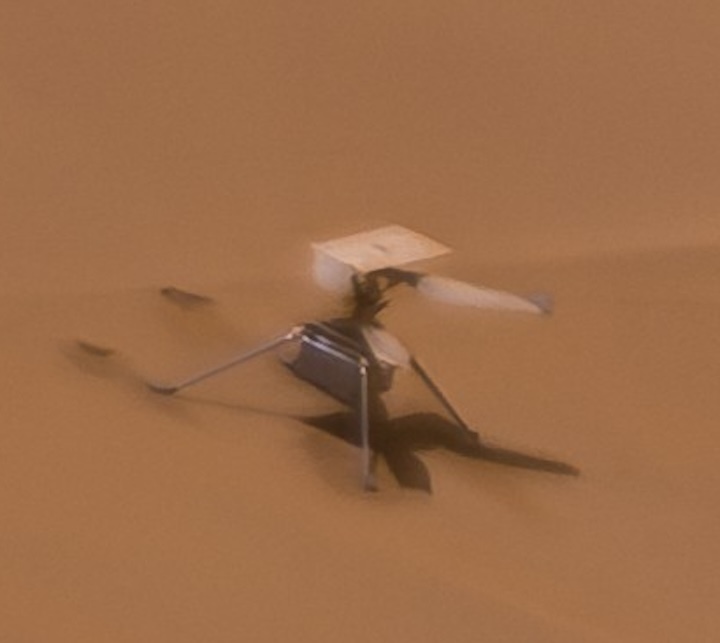
An image of Ingenuity captured by Perseverance's SuperCam RMI instrument.
It has now been several weeks since NASA's tenacious helicopter on Mars, Ingenuity, made its final flight above the red planet.
This happened last month. On January 6, Ingenuity flew 40 feet (12 meters) skyward but then made an unplanned early landing after just 35 seconds. Twelve days later, operators intended to troubleshoot the vehicle with a quick up-and-down test. Data from the vehicle indicated that it ascended to 40 feet again during this test, but then communications were ominously lost at the end of the flight.
On January 20, NASA reestablished communications with the helicopter, but the space agency declared an end to its flying days after an image of the vehicle's shadow showed that at least one of its blades had sustained minor damage. This capped an end to a remarkable mission during which Ingenuity exceeded all expectations.
During a news conference to discuss the end of the mission, NASA officials said they may never know exactly what happened during Ingenuity's final two ultimately fatal flights. But thanks to Perseverance, the rover that brought Ingenuity to the Martian surface and helped relay communications back to Earth, engineers picked up a powerful clue this past weekend.
Finding a missing blade
The rover is now moving away from the helicopter and bound for other scientifically interesting vistas. After recently getting to within about 1,500 feet (450 meters) of Ingenuity, Perseverance likely will never be as close again. However, as it was moving away, the rover turned its SuperCam Remote Micro-Imager toward the helicopter for the final time. Those images, captured this weekend, were sent back to Earth on Sunday. A German design student, Simeon Schmauß, processed some of these images to form a mosaic showing the helicopter and its surroundings in Neretva Vallis, an ancient channel through which water once flowed.
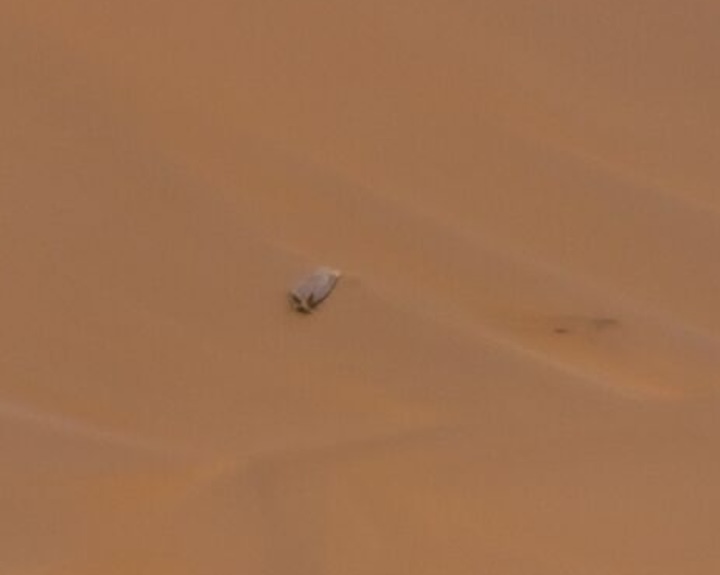
A broken blade in an ancient channel on Mars.
The new images are remarkable in that they reveal Ingenuity more clearly than before and show that one rotor blade was completely broken off. Additional sleuthing revealed that this blade lay about 15 meters away from Ingenuity on the red Martian sands, apparently winging away from the helicopter prior to or during a landing of the vehicle on its final flight last month.
This additional data will undoubtedly help the engineers and scientists who flew the helicopter to piece together its final moments—and quite possibly make the design of future flying vehicles on Mars and other worlds more robust.
Quelle: arsTechnica
----
Update: 5.04.2024
.
Thousands of strange white rocks found on Mars. Will they ever be brought to Earth?
"These are very unusual rocks and we're trying to figure out what's been going on."

NASA's Perseverance Mars rover used its dual-camera Mastcam-Z imager to capture this image of "Santa Cruz," a hill within Jezero Crater, on April 29, 2021. (Image credit: NASA/JPL-Caltech/ASU/MSSS)
Mars' rusty red surface may have given it its famous "Red Planet" status, but it would also appear that thousands of white rocks are strangely littered on the Martian ground. NASA's Perseverance rover, a robotic geologist that has been exploring the Jezero Crater since early 2021, puzzled scientists when it delivered images of over 4,000 light-toned, pebble-sized rocks scattered all over the crater floor.
"These are very unusual rocks and we're trying to figure out what's been going on," Candice Bedford, a planetary scientist at Purdue University in Indiana and a member of the Mars 2020 science team, said at the Lunar and Planetary Science Conference (LSPC) last month.
The announcement comes as NASA wraps up an architectural review of returning Martian rocks to Earth as part of the agency's ambitious Mars Sample Return (MSR) program.
The imaged white rocks are what scientists refer to as "floats," meaning they have been removed and transported from their original habitats; some are smooth with pits while others appear to be an amalgamation of multiple layers. Initial analyses, conducted with Perseverance's onboard instruments, revealed the rocks are dehydrated — not only in water content, but also in other minerals including iron, magnesium, calcium and sodium. "These are pretty depleted in a lot of things," Bedford said.
The team is particularly interested in the origins of these unusual rocks as their sources can reveal clues about the Red Planet's past, including precisely when water would've flooded the Jezero crater, which we see as an arid stretch of land today. Despite spotting more than 4,000 such rocks, Perseverance hasn't managed to see even a hint of what's known as an "outcrop" related to the rocks, which is essentially a bedrock of similar properties that'd jut out of the Martian surface.
The rocks' dehydrated nature suggests they were heated and metamorphosed by either lava flows or asteroid impacts elsewhere on Mars and later dumped onto the crater floor, said Bedford. Whatever the specific process may have been, she and her team suspect it would have occurred relatively recently in terms of Jezero Crater's geologic history.
The Perseverance rover, which has driven more than 15 miles (24.8 kilometers) since its arrival on Mars, celebrated 1,000 days of science last December, which also marked the official completion of the mission it was originally designed to do. It has now filled 26 of its 43 Mars rock sample tubes, mission team members shared at LPSC. "Each sample has innumerable grains that we could potentially study for forever, essentially," said Benjamin Weiss, a professor of planetary sciences at the Massachusetts Institute of Technology and a member of the Mars 2020 team.
As part of a bonus mission that kicked off this spring, Bedford said Perseverance began inching its way toward the Jezero Crater rim, and its long-distance camera has already imaged more light-toned rocks scattered in that area as well.
All of these puzzling rocks, however, are not the only reason why scientists are eager to get Perseverance to the crater rim and possibly beyond. There, they believe a unique geology exists, one that hasn't yet been encountered within the crater floor. That includes pre-Jezero rocks that may have records of the formation of Mars' crust and early climate. It may even hold evidence of biosignatures.
Scientists are currently tagging a variety of interesting sampling locations while mapping the rim itself in more detail, said Lisa Mayhew, a research associate at the University of Colorado, Boulder. Of much interest to scientists is a terrain adjacent to Jezero crater called Nili Planum, whose rocks they think would have formed in warm conditions during a time when life most likely evolved — if it ever existed on the now-barren world, that is. Sampling such rocks "would provide huge added scientific value to the cache that's already existing on Perseverance," said Mayhew.
That scientific value, however, can only be fully realized after those rocks are returned to Earth.
Scientists need to time-date them using equipment on Earth, without which they wouldn't have a precise timeline for when the Red Planet was habitable and when it became parched. "It doesn't overstate to say it will revolutionize our understanding of Mars," said Weiss.
Questions remain about the MSR program, which NASA is spearheading, including when and how the agency plans to return collected samples to Earth. Last October, NASA commissioned a response team (MIRT) to evaluate alternative approaches to MSR after an independent review board (IRB) found the current architecture would lead to overruns in cost and schedule.
"Much of the work is already complete," said Meenakshi Wadhwa, a planetary scientist at Arizona State University and MSR's principal scientist. The MIRT's recommendation report for a new approach was expected by the end of March, followed by a revised plan and budget by NASA sometime in April, she said.
The agency's fiscal year 2025 budget proposal, made public March 11, allocated $2.7 billion for planetary science but the funding for MSR remained "TBD." NASA's budget this year and next will be announced in April after the MIRT review is completed, NASA Administrator Bill Nelson told reporters at the time.
Quelle: SC
----
Update: 18.04.2024
.
Comet Geyser: Perseverance’s 24th Rock Core
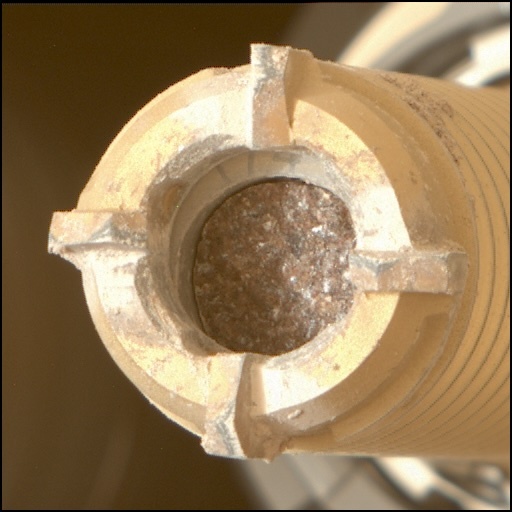
Bunsen Peak is named after a prominent peak in Yellowstone National, Park, Wyoming, USA, and the namesake for Comet Geyser is the silica-sintered cone geyser also in Yellowstone National Park.
Although this rock’s origin remains under investigation and the rover team continues to explore different hypotheses, this core is particularly exciting because it appears to be composed primarily of two minerals: carbonate and silica. Carbonate and silica are both excellent minerals for preserving biosignatures (ancient signs of life). These minerals also have the potential to record the environmental conditions in which they formed, making them important minerals for understanding the habitability of Jezero crater billions of years ago.
The presence of carbonate within the Comet Geyser sample suggests that water, carbon dioxide, and chemical elements derived from rocks or sediments in and around ancient Jezero crater once reacted here to form carbonate. Carbonate minerals from Earth’s rock record are often used to reconstruct ancient climate--including conditions like temperature, precipitation, and aridity--and the history of life. Similarly, silica phases form when water interacts with rocks or sediments. The composition and crystallinity of silica can reveal the extent of the interaction with water, such as the intensity or duration of weathering and the pressure/temperature conditions during formation.
On Earth, biosignatures can be preserved in carbonate and silica for millions of years, or even billions of years in the case of silica. Some of the oldest evidence we have of life on Earth is from rocks that contain fragments of microbial cells that were “permineralized” by silica, a fossilization process that entombs the residues of ancient life and protects them from degradation. Thus, rocks containing these materials are considered among the highest priority samples for investigating whether Jezero crater was once host to microbial life. Perseverance’s 24th core sample at Bunsen Peak represents a significant milestone towards collection of a scientifically diverse set of samples for eventual return to Earth as part of the Mars Sample Return mission.
With rock core #24 now onboard, Perseverance presses forward towards its next strategic objective of investigating a location called Bright Angel, which is a light-toned outcrop exposed in the ancient channel wall of Neretva Vallis. Challenges may arise on this journey, as the terrain ahead is littered with sharp boulders and sand that are proving difficult for the rover’s auto-navigation system. The mission’s rover planners are working hard to manually navigate this tricky terrain. In the meantime, the science team is eagerly anticipating the secrets the rocks of Bright Angel may hold!
Written by Adrian Broz, Postdoctoral Scientist at Purdue University/University of Oregon
Quelle: NASA
----
Update: 15.06.2024
.
NASA’s Perseverance Fords an Ancient River to Reach Science Target
Originally thought of as little more than a route clear of rover-slowing boulders, Neretva Vallis has provided a bounty of geologic options for the science team.
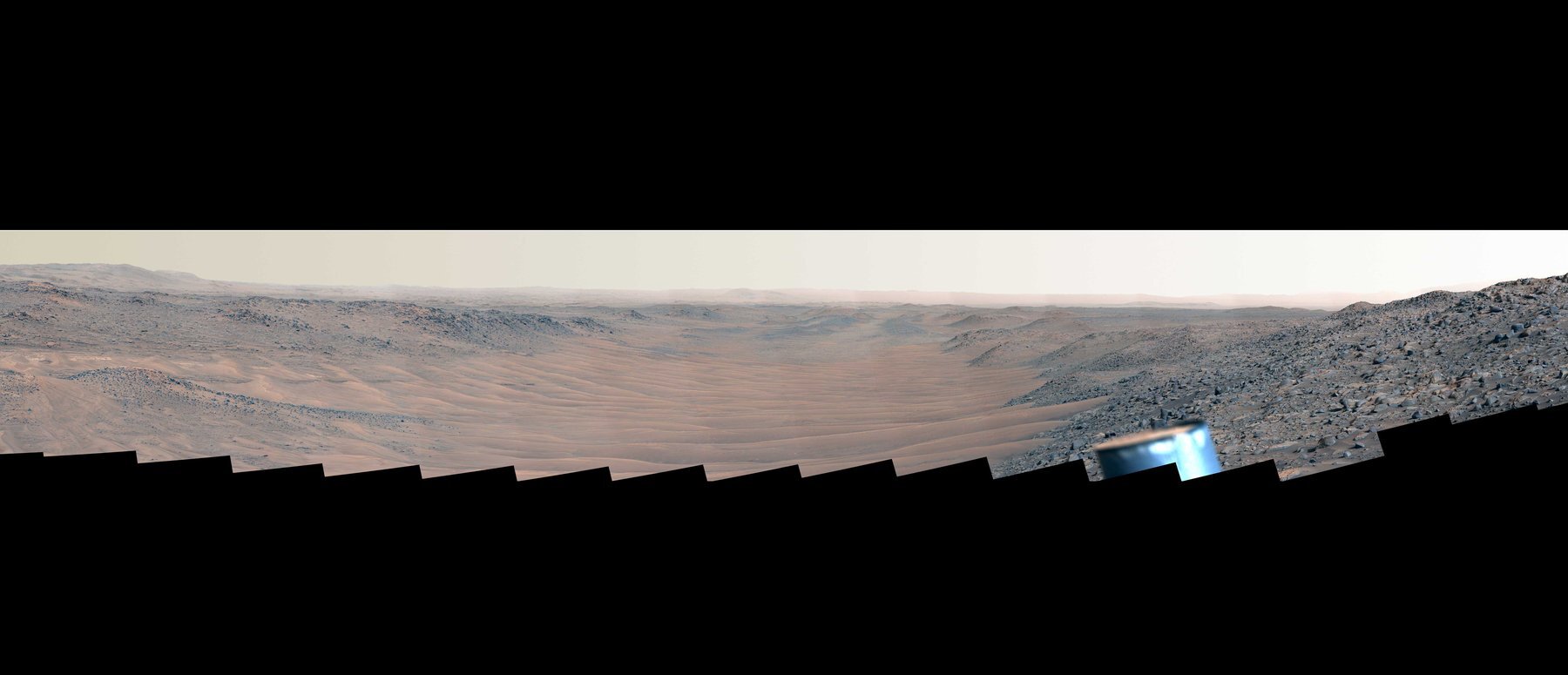
Perseverance captured this mosaic looking downstream of the dune-filled Neretva Vallis river channel on May 17. The channel fed Jezero Crater with fresh water billions of years ago. Credit: NASA/JPL-Caltech/ASU/MSSS
After detouring through a dune field to avoid wheel-rattling boulders, NASA’s Perseverance Mars rover reached its latest area of scientific interest on June 9. The route change not only shortened the estimated drive time to reach that area — nicknamed “Bright Angel” — by several weeks, but also gave the science team an opportunity to find exciting geologic features in an ancient river channel.
Perseverance is in the later stages of its fourth science campaign, looking for evidence of carbonate and olivine deposits in the “Margin Unit,” an area along the inside of Jezero Crater’s rim. Located at the base of the northern channel wall, Bright Angel features rocky light-toned outcrops that may represent either ancient rock exposed by river erosion or sediments that filled the channel. The team hopes to find rocks different from those in the carbonate-and-olivine-rich Margin Unit and gather more clues about Jezero’s history.

Stitched together from 18 images taken by NASA’s Perseverance rover, this mosaic shows a boulder field on “Mount Washburn” on May 27. Intrigued by the diversity of textures and chemical composition in the light-toned boulder at center, the rover’s science team nicknamed the rock “Atoko Point.” Credit: NASA/JPL-Caltech/ASU/MSSS
To get to Bright Angel, the rover drove on a ridge along the Neretva Vallis river channel, which billions of years ago carried a large amount of the water that flowed into Jezero Crater. “We started paralleling the channel in late January and were making pretty good progress, but then the boulders became bigger and more numerous,” said Evan Graser, Perseverance’s deputy strategic route planner lead at NASA’s Jet Propulsion Laboratory in Southern California. “What had been drives averaging over a hundred meters per Martian day went down to only tens of meters. It was frustrating.”
Channel Surfing
In rough terrain, Evan and his team use rover imagery to plan drives of about 100 feet (30 meters) at a time. To go farther on any given Martian day, or sol, planners rely on Perseverance’s auto-navigation, or AutoNav, system to take over. But as the rocks became more plentiful, AutoNav would, more times than not, determine the going was not to its liking and stop, dimming the prospects of a timely arrival at Bright Angel. The team held out hope, however, knowing they might find success cutting across a quarter-mile (400-meter) dune field in the river channel.

NASA’s Perseverance rover was traveling in the ancient Neretva Vallis river channel when it captured this view of an area of scientific interest named “Bright Angel” — the light-toned area in the distance at right — with one of its navigation cameras on June 6.
Credit: NASA/JPL-Caltech
“We had been eyeing the river channel just to the north as we went, hoping to find a section where the dunes were small and far enough apart for a rover to pass between — because dunes have been known to eat Mars rovers,” said Graser. “Perseverance also needed an entrance ramp we could safely travel down. When the imagery showed both, we made a beeline for it.”
The Perseverance science team was also eager to travel through the ancient river channel because they wanted to investigate ancient Martian river processes.
Rock Star
With AutoNav helping guide the way on the channel floor, Perseverance covered the 656 feet (200 meters) to the first science stop in one sol. The target: “Mount Washburn,” a hill covered with intriguing boulders, some of a type never observed before on Mars.
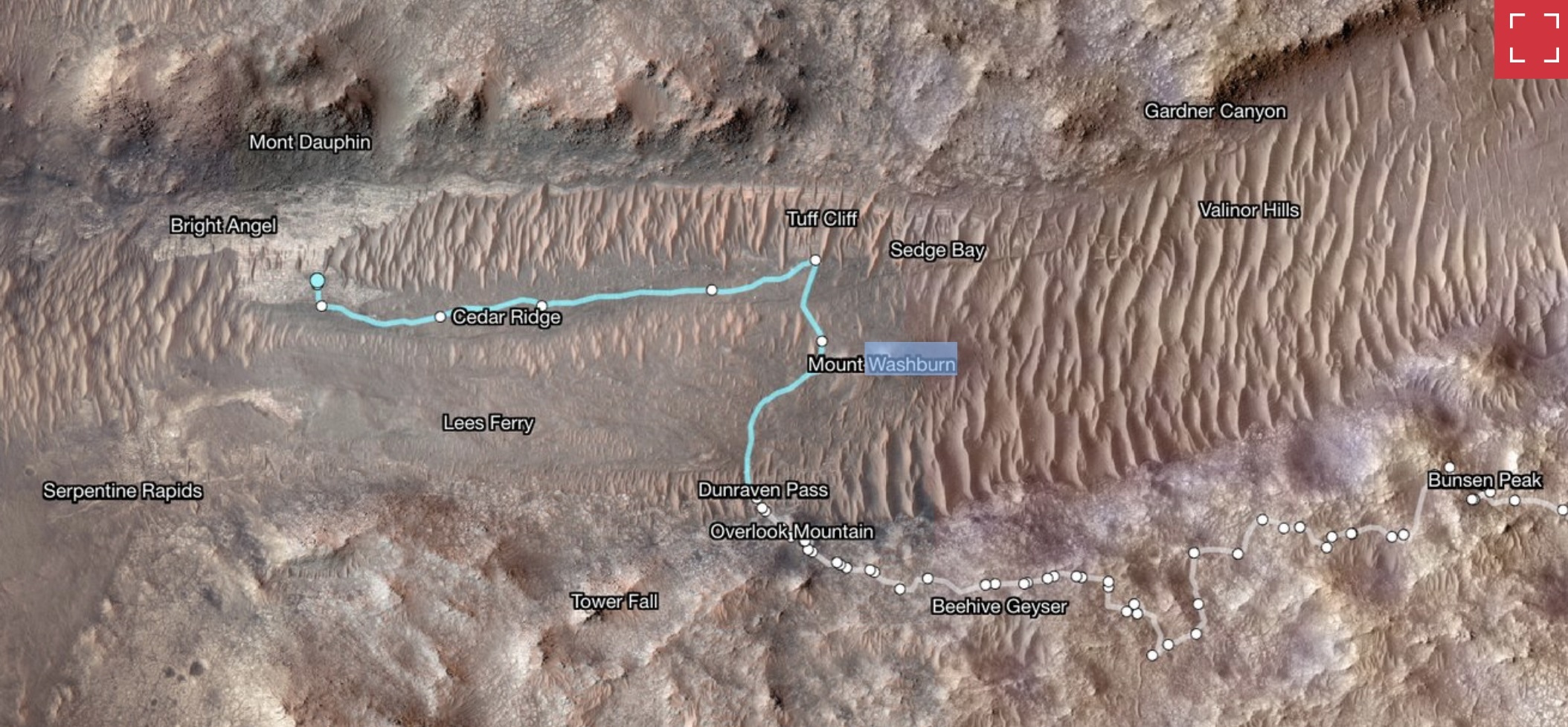
Superimposed on an image from NASA’s Mars Odyssey orbiter, this map shows Perseverance’s path between Jan. 21 and June 11. White dots indicate where the rover stopped after completing a traverse beside Neretva Vallis river channel. The pale blue line indicates the rover’s route inside the channel.
“The diversity of textures and compositions at Mount Washburn was an exciting discovery for the team, as these rocks represent a grab bag of geologic gifts brought down from the crater rim and potentially beyond,” said Brad Garczynski of Western Washington University in Bellingham, the co-lead of the current science campaign. “But among all these different rocks, there was one that really caught our attention.” They nicknamed it “Atoko Point.”
Some 18 inches (45 centimeters) wide and 14 inches (35 centimeters) tall, the speckled, light-toned boulder stands out in a field of darker ones. Analysis by Perseverance’s SuperCam and Mastcam-Z instruments indicates that the rock is composed of the minerals pyroxene and feldspar. In terms of the size, shape, and arrangement of its mineral grains and crystals — and potentially its chemical composition — Atoko Point it is in a league of its own.
Some Perseverance scientists speculate the minerals that make up Atoko Point were produced in a subsurface body of magma that is possibly exposed now on the crater rim. Others on the team wonder if the boulder had been created far beyond the walls of Jezero and transported there by the swift Martian waters eons ago. Either way, the team believes that while Atoko is the first of its kind they’ve seen, it won’t be the last.
After leaving Mount Washburn, the rover headed 433 feet (132 meters) north to investigate the geology of “Tuff Cliff” before making the four-sol, 1,985-foot (605-meter) journey to Bright Angel. Perseverance is currently analyzing a rocky outcrop to assess whether a rock core sample should be collected.
More About the Mission
A key objective for Perseverance’s mission on Mars is astrobiology, including caching samples that may contain signs of ancient microbial life. The rover will characterize the planet’s geology and past climate, pave the way for human exploration of the Red Planet, and be the first mission to collect and cache Martian rock and regolith.
Subsequent NASA missions, in cooperation with ESA (European Space Agency), would send spacecraft to Mars to collect these sealed samples from the surface and return them to Earth for in-depth analysis.
The Mars 2020 Perseverance mission is part of NASA’s Moon to Mars exploration approach, which includes Artemis missions to the Moon that will help prepare for human exploration of the Red Planet.
NASA’s Jet Propulsion Laboratory, which is managed for the agency by Caltech, built and manages operations of the Perseverance rover.
Quelle: NASA
----
Update: 19.06.2024
.
NASA's Perseverance Mars rover enters new Red Planet territory: 'Bright Angel'
"We had been eyeing the river channel just to the north as we went, hoping to find a section where the dunes were small and far enough apart for a rover to pass between."
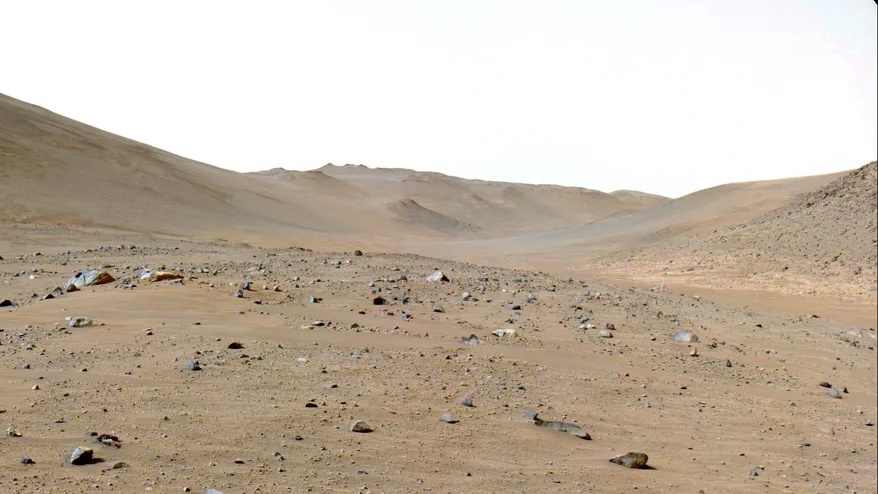
NASA's Perseverance rover was traveling in the channel of an ancient river, Neretva Vallis, when it captured this view of an area of scientific interest nicknamed "Bright Angel" – the light-toned area in the distance at right. (Image credit: NASA)
Since January, NASA's Perseverance rover has been tracing the south side of Neretva Vallis, which is possibly the fossil of a river that once fed the rover's landing site in Jezero Crater.
In the distance, Perseverance's operators could see the glimmer of its next destination: Bright Angel, so named for the light-toned outcrops that may be ancient rocks uncovered by the previously running river.
But what had been a relatively smooth trip turned into a slog as Perseverancerolled into a field of unforeseen boulders. After days of slogging, the decision was made to reroute Perseverance across a dune field and through the river channel. It proved the correct decision: Now, Perseverance has reached Bright Angel's landing at last.
"We had been eyeing the river channel just to the north as we went, hoping to find a section where the dunes were small and far enough apart for a rover to pass between," said Evan Graser, an engineer who helps plan Perseverance’s route, in a statement. "Perseverance also needed an entrance ramp we could safely travel down. When the imagery showed both, we made a beeline for it."

Composed of 18 images, this natural-color mosaic shows a boulder field on "Mount Washburn" in Mars' Jezero Crater. The Perseverance science team nicknamed the light-toned boulder with dark speckles near the center of the mosaic "Atoko Point." The images were acquired by NASA's Perseverance Mars rover on May 27, 2024, the 1,162nd Martian day, or sol, of the mission. (Image credit: NASA)
Perseverance relies on AutoNav, a system that allows the rover to navigate itself. Where earlier Mars rovers required total control from Earth, Perseverance's guides can give it a general route, and AutoNav will handle the minute-to-minute steering. At first, AutoNav could circumnavigate the boulders in Perseverance's path. But soon, the boulders became too large for the system to handle.
"What had been drives averaging over a hundred meters per Martian day went down to only tens of meters. It was frustrating" said Graser in the statement.
Just to the north of Perseverance's course, a field of Martian dunes separated it from the river channel's floor. If Perseverance could cross the dunes, it could leave the boulders behind. However, navigating through such dunes is risky, as the Martian sands have a way of trapping rovers — just ask Spirit, which got stuck in 2009. Fortunately, these dunes were small and spread out enough for Perseverance to chart a course through them.
Now in the river channel, Perseverance could cover some 200 meters (650 feet) per Martian day. The new course was fortunate for scientific reasons, too. In the midst of the channel Perseverance encountered the so-called Mount Washburn, a rocky hill that presented scientists with exciting geological opportunities. One of them was a curious rock that scientists speculate may be the product of a subsurface magma pool.
Then, after reaching a cliff near the north edge of the channel, Perseverance turned west.
Four Martian days later, the rover reached Bright Angel and began to analyze its rocks. This begs a question: Should Perseverance collect a rock sample here?
Quelle: SC
----
Update: 24.06.2024
.
Perseverance Mars rover digs into intriguing 'Bright Angel' rock formation
Some scientists think that Bright Angel's rocks represent older material that was exposed by now-vanished water eroding the ground.
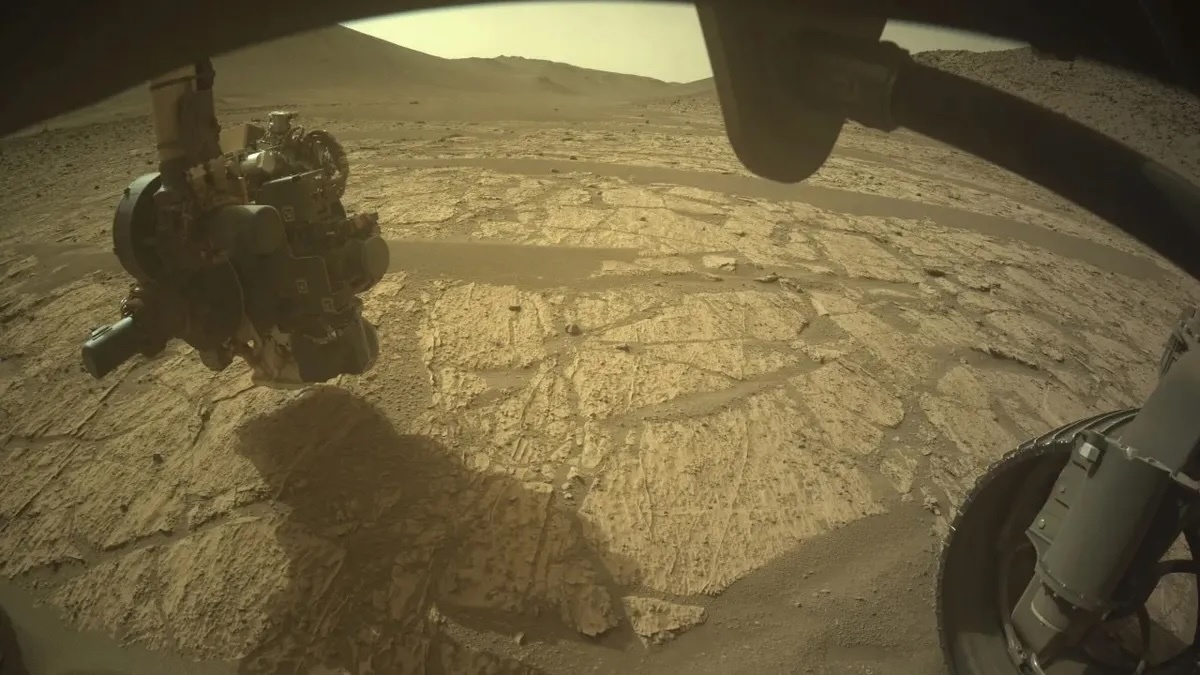
NASA’s Perseverance Mars rover acquired this image with its Front Right Hazard Avoidance Camera A on June 16, 2024. It shows the area in front of the rover at a site called Bright Angel, with the arm extended as the PIXL instrument investigates the surface. (Image credit: NASA/JPL-Caltech)
Last week, after braving a field of sand dunes and traversing the desiccated remnants of an ancient river, NASA's Perseverance rover reached the shining rock outcropping on the Martian horizon that the rover's operators have named "Bright Angel."
Perseverance has now begun its scientific investigation of a very unique place in its surroundings. Its first action: digging into the ground, scanning and imaging the Mars soil with X-rays. Over the coming months, scientists will parse the data that Perseverance sends back.
Bright Angel got its name for being an unusually light-colored patch of rock in images taken from orbit. Against the Martian landscape, the outcropping's dramatic appearance caught scientists' eyes.
The patch's site at the edge of Neretva Vallis, a dried river channel that feeds into Perseverance's Jezero Crater landing site — and a channel that Perseverance had trailed for weeks — suggested that Bright Angel might harbor interesting details about Mars' wetter past.
As Perseverance approached Bright Angel, the rover's operators and mission scientists on Earth got their first close-up looks at the place. Some scientists think that Bright Angel's rocks represent older material that was exposed by now-vanished water eroding the ground.
After several days of sightseeing and photo-taking, Perseverance began to dig, lowering its high-speed drill into the ground. The rover then cleared the dust away by blasting it with nitrogen gas. Performing such a shallow dig, which scientists call an abrasion, allows the rover to clear a circle of the Martian surface's weathered outer layer and get at the pristine rock below.
On this spot, Perseverance deployed its PIXL instrument, a device that lights up the Martian surface with an X-ray beam and measures the light that bounces back. It's too soon for scientists to have processed the data, but over the coming months, they will analyze it to learn more about how Bright Angel formed and how it relates to Neretva Vallis' former river.
Now, Perseverance's science team will determine if the rover should take an even more drastic step — determining whether samples from Bright Angel will make fine additions to its collection. If so, a planned return campaign may deliver Bright Angel rocks back to Earth.
Quelle: SC
